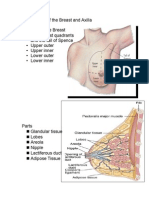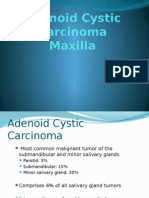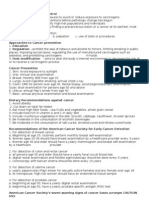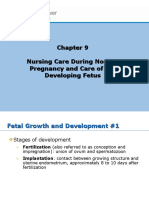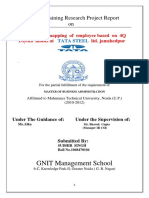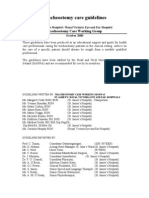Prostatic Cancer
Prostatic Cancer
Uploaded by
Parixit DasCopyright:
Available Formats
Prostatic Cancer
Prostatic Cancer
Uploaded by
Parixit DasOriginal Description:
Original Title
Copyright
Available Formats
Share this document
Did you find this document useful?
Is this content inappropriate?
Copyright:
Available Formats
Prostatic Cancer
Prostatic Cancer
Uploaded by
Parixit DasCopyright:
Available Formats
Prostate Cancer
Share on gmailShare on facebookShare on emailShare on linkedinMore Sharing Services0
Prostate Cancer Symptoms
Prostate Cancer Diagnosis
Prostate Cancer Treatment
What is prostate cancer?
Prostate cancer is a malignant tumor develops in prostatic tissues, it is the result of irregular growth of prostatic acinar cells.
What is the incidence of prostate cancer?
Prostate cancer rarely develops in the males younger than 45. But its incidence increases sharply as age increases and most
prostate cancer patients are older than 65 years old. Basically, the incidence is doubling each additional 10 years in those males
older than 40. And the risk for the males in 50-59 years old is 10%, but for the ones in 80-89 years old, the risk goes up to 70%.
What are the risk factors of prostate cancer?
Absolute risk factors:
1) Age, it is the main risk factor of prostate cancer.
2) Family history, the incidence would obviously increase in those males whose direct relatives have suffered from prostate
cancer.
3) Race. African Americans got the top incidence of prostate cancer, after that is Spanish and American white people and black
African got the lowest incidence worldwide.
4) Irregular pathological changes of cells occur inside prostate. The incidence remarkably goes up in those males who have
intraepithelial canceration of high-level prostate cancer.
Relative risk factors
1) Diets: prostate cancer is inclined to develop in the males who often have the diets that are rich in animal fat.
2) Androgen level. Internal androgen can stimulate the growth of prostate and is one of the inducements of prostate cancer.
Symptoms of prostate cancer
1. Obstructive symptoms. Such as difficulty of urination, urine retention, pain, hematuria and urinary incontinence occur.
2. Local infiltrating symptoms. Vesicorectal space usually is the first being involved, it includes prostate, seminal vesicle,
spermaductus, inferior extremity of ureter and other organs. If the tumor encroaches to and depresses on spermaductus would lead
to lumbar pain and lateral pain in testicle.
3. Other metastatic symptoms. Prostate cancer is tending to develop bone metastases. It doesn’t present any symptoms at the
beginning. But there are cases of prostate cancer being found because of the nerve depression or fracture causing from bone
metastases.
Detections of prostate cancer
1. Rectal touch
2. Serum prostate-specific antige assay
3. Assayof specifica acid phosphatase of prostate
4. Ultrasound examination
5. X-ray examination
6. Biopsy
7. CT scan or MRI
How does prostate cancer spread?
Prost cancer can spread extensively through blood and veins, and mostly extends to lungs and bones. The bones like pelvis,
vertebra, ribs, femurs, clavicles, etc. can also be involved. But how does prostate cancer spread to vertebra, some specialists
thought that was by vertebral venous plexus. However, there is proof supporting that prostate cancer spreads in the same way of
other cancers, systemic circulation. In that case, the cases with vertebra metastases are probably have lung metastases.
Treatments available
1. Surgery. Surgery is the most common treatment to prostate cancer. Through open resection operation of prostate cancer to
remove partial or the whole prostate being affected so as to stop the cancer from spreading.
2. Radiotherapy. It can be divided to below methods: 1) External radiation. 2) Radiation in tela, it normally is combined with
radical correction of prostate cancer or pelvic lymphadenectomy. 3) General radiation, it can relieve the local pain causing from bone
metastases and stop the development of cancer.
3. Chemotherapy, it is a general treatment for prostate cancer by chemicals, which can effectively control the spread of cancer
cells.
4. Traditional Chinese medicine. To treat prostate cancer by traditional Chinese medicine, on one hand can effectively kill and
constrain cancer cells to relieve the condition, on the other hand can generally adjust clinical condition of patient to enhance
immunity and improve overall cure effect.
5. Minimally invasive therapy. Minimally invasive technology as a new technique in cancer treatments, it features small trauma,
no complaints, less bleeding, fast recovery and so on.
Specialist from Modern Cancer Hospital Guangzhou figured out that, the treatment of prostate cancercannot singly tend to local
or one treatment, it should be based on the stage, tissue type and biological behavior of different tumors and general condition of
patient, to combine surgery, radiotherapy,chemotherapy, traditional Chinese medicine and minimally invasive therapy together in
treatments to gain the best cure effect.
What are the rehabilitation measures of prostate cancer?
1. Interference of psychological rehabilitation. It helps patient eliminate the depression and anxiety, while it can encourage
patients to be open-minded and keep a strong perseverance to cooperate with treatments.
2. Interference of diets and intestinal care. In order to reduce the incidence of constipation after operation, the patient should
take more bland and easy digested fruits and vegetables, of which are rich in fibrin. Beside, drink more water and have defecation
regularly in the morning each day to ensure a smooth bowel movement. Avoid spicy and irritating diets to prevent from constipation.
3. Interference of cystospasm care. When cystospasm occurs, the patient should take a deep breath and the family members
can do some massage to relieve the pain. If post operative continuous cystospasm develops, pain killer should be given.
In addition, nice sleeping helps the patient recover, so a reasonable work-rest schedule to create a comfortable and proper
sleeping environment is important.
What kinds of supports can be obtained?
Practice proves that the clinic team services composed by multiple disciplines like oncosurgery, oncology, pathology,
imageology and anesthesia doctors as well as professional nurses, can provide patients with most effective, most suitable and most
economic treatment plan, and also can greatly improve the therapeutic effect of treating cancer patients.
“One station” medical system constructed by Modern Cancer Hospital Guangzhou combining multiple disciplines, can perform
comprehensive diagnosis and treatment for patients under the condition of without adding patients’ burden. Therefore, on one hand,
it can provide all-round and heartfelt medical services, and on the other hand, it improves medical efficiency and level. There are
many channels can be applied to conduct the communication between patients and doctors, like online consultation, email,
telephone conversation, and face-to-face consultation. All these consultation services can effectively help patients to fight the
cancer. While the medical team faced by the patients includes doctors, nurses, dietitians, interpreters and so on to meet various
demands in different level of different countries. Patients would be more confident under the unobstructed communication
environment to cooperate the hospital to diagnose and treat the diseases.
You might also like
- Case Study 1Document9 pagesCase Study 1Mark SanchezNo ratings yet
- Nursing Care Plan: CancerDocument6 pagesNursing Care Plan: Cancerneuronurse75% (8)
- Complications of CSF Shunting in Hydrocephalus - Prevention, Identification, and Management (PDFDrive)Document320 pagesComplications of CSF Shunting in Hydrocephalus - Prevention, Identification, and Management (PDFDrive)Erick DjuandaNo ratings yet
- Lymphatic SystemDocument4 pagesLymphatic Systempriya garciaNo ratings yet
- Mariano Marcos State University: College of Health SciencesDocument43 pagesMariano Marcos State University: College of Health ScienceskennethNo ratings yet
- Colon Rectal CancerDocument6 pagesColon Rectal Cancerbryantmaroney811No ratings yet
- Learning Outcomes Chapter 16-Lewis Medical SurgicalDocument11 pagesLearning Outcomes Chapter 16-Lewis Medical Surgicalfirestartergirl100% (1)
- PMSDocument6 pagesPMSParixit DasNo ratings yet
- LESSON PLAN On Sample CollectionDocument18 pagesLESSON PLAN On Sample CollectionJasmine PraveenNo ratings yet
- Prostate Cancer: Signs and SymptomsDocument5 pagesProstate Cancer: Signs and SymptomsLicio LentimoNo ratings yet
- Penis Cancer, A Simple Guide To The Condition, Treatment And Related ConditionsFrom EverandPenis Cancer, A Simple Guide To The Condition, Treatment And Related ConditionsRating: 5 out of 5 stars5/5 (1)
- Prostate CancerDocument8 pagesProstate CancerJohnNo ratings yet
- CancerDocument24 pagesCancerarshadmuhammedNo ratings yet
- Case Study Breast CADocument13 pagesCase Study Breast CABorja, Kimberly GraceNo ratings yet
- Cardiology Medsurg LectureDocument9 pagesCardiology Medsurg LectureTine GuibaoNo ratings yet
- Breast Cancer UpdatedDocument20 pagesBreast Cancer UpdatedHAZEL LEELA A P RICHARDNo ratings yet
- B. Pathophysiology: Clinical Aspects of Cancer DiagnosisDocument10 pagesB. Pathophysiology: Clinical Aspects of Cancer DiagnosisAbigael Patricia GutierrezNo ratings yet
- Week 15 Brain, Breast, Lung Cancer (Vid Lec 1-2 Mam Muji)Document22 pagesWeek 15 Brain, Breast, Lung Cancer (Vid Lec 1-2 Mam Muji)jmmacar19No ratings yet
- Nasopharyngeal Cancer CompleteDocument54 pagesNasopharyngeal Cancer CompleteAmemonsajaah AmemonNo ratings yet
- CancerDocument16 pagesCancerRobert َMiranda100% (2)
- Ms 1 Integumentary NursingDocument10 pagesMs 1 Integumentary NursingTrinity Veach100% (1)
- Logic in CancerDocument21 pagesLogic in CancerCatherine ManaloNo ratings yet
- Week 16 Gi and Gyne CancerDocument15 pagesWeek 16 Gi and Gyne Cancerjmmacar19No ratings yet
- Immunology Intensive ReviewerDocument21 pagesImmunology Intensive ReviewerAllysa PrestonNo ratings yet
- Lecture Handouts Oncology NursingDocument12 pagesLecture Handouts Oncology NursingTiffany Luv AdriasNo ratings yet
- Oncology BulletsDocument11 pagesOncology BulletsDonaJeanNo ratings yet
- Functional Health Patterns Assessment ToolDocument4 pagesFunctional Health Patterns Assessment ToolKim Caitlin Carbolico Clasiete100% (1)
- Professional AdjustmentDocument10 pagesProfessional AdjustmentKate BasaNo ratings yet
- Chemotherapy - Alkylating AgentsDocument33 pagesChemotherapy - Alkylating AgentsNolan100% (1)
- CHN NotesDocument7 pagesCHN NotesAnvi Turingan PedronanNo ratings yet
- Viray, Karmina Vianca Yutangco, RoquitoDocument21 pagesViray, Karmina Vianca Yutangco, RoquitoKen Edward ZataNo ratings yet
- Cellular Aberrations NotesDocument22 pagesCellular Aberrations NotesH50% (2)
- Breast Cancer Case Study: Answers For LifeDocument4 pagesBreast Cancer Case Study: Answers For LifeFaye Mie VelascoNo ratings yet
- Week 17Document13 pagesWeek 17jmmacar19No ratings yet
- NOTES - Finals Compilation Notes FundaDocument140 pagesNOTES - Finals Compilation Notes FundaJan Dannise TiuNo ratings yet
- Cancer Management and Supportive Therapies: OutlineDocument24 pagesCancer Management and Supportive Therapies: OutlineLeslie CruzNo ratings yet
- Assessment of The Breast and AxillaDocument5 pagesAssessment of The Breast and Axillamalyn1218100% (1)
- Nursing Care of Clients With Cellular AberrationDocument68 pagesNursing Care of Clients With Cellular Aberrationcoosa liquorsNo ratings yet
- Esophageal CancerDocument3 pagesEsophageal CancerChanthorn SokNo ratings yet
- Prepared By: Anna Marie M. Montalban, RN, Us-RnDocument71 pagesPrepared By: Anna Marie M. Montalban, RN, Us-RnPrecai Permangil100% (2)
- Cancer of The ColonDocument8 pagesCancer of The Colonnot your medz duranNo ratings yet
- GIT DisordersDocument28 pagesGIT Disordersbpt2100% (1)
- 1st Lecture (NCM106 ABC I) Care of Clients in Cellular Aberrations, ABC, Emergency and Disaster NursingDocument14 pages1st Lecture (NCM106 ABC I) Care of Clients in Cellular Aberrations, ABC, Emergency and Disaster NursingKamx Mohammed100% (1)
- Case Study Breast CancerDocument3 pagesCase Study Breast CancerJustin Joshua Derilo OrdoñaNo ratings yet
- Finals - Cellular AberrationsDocument36 pagesFinals - Cellular AberrationsMaggay LarsNo ratings yet
- B. Benign Prostatic Hyperplasia: - Thrombocytopenia and Increased LymphocytesDocument30 pagesB. Benign Prostatic Hyperplasia: - Thrombocytopenia and Increased LymphocytesKyla Shain GallegoNo ratings yet
- Competency Appraisal Midterm ExaminationsDocument9 pagesCompetency Appraisal Midterm ExaminationsRellie Castro100% (1)
- Concept Map CholesectomyDocument3 pagesConcept Map CholesectomyDoreen Claire100% (1)
- Cervical CancerDocument22 pagesCervical CancerShandy Suwanto PutraNo ratings yet
- Oncology Handouts PDFDocument21 pagesOncology Handouts PDFPhilip Simangan100% (1)
- Prostate Cancer Patho (Patient Based) by Francis OliverosDocument2 pagesProstate Cancer Patho (Patient Based) by Francis Oliverosfrancis00090100% (3)
- Adenoid Cystic Carcinoma LectureDocument20 pagesAdenoid Cystic Carcinoma LecturehernelandNo ratings yet
- CHN Finals-ReviewerDocument14 pagesCHN Finals-ReviewerKayobi BuenviajeNo ratings yet
- Introduction To TransplantationDocument3 pagesIntroduction To TransplantationGerardLumNo ratings yet
- Oncology NotesDocument7 pagesOncology Notesaurezea100% (1)
- Ch09Document32 pagesCh09Bridget Shienne DaculaNo ratings yet
- Brain CancerDocument22 pagesBrain CancerNatália Martins HoffmannNo ratings yet
- Med SurgDocument4 pagesMed SurgGeraldine MaeNo ratings yet
- Case Study: PharyngitisDocument3 pagesCase Study: PharyngitisRestian Rony SaragiNo ratings yet
- Prostate Cancer Clinical Pathway - July 2020Document4 pagesProstate Cancer Clinical Pathway - July 2020VincentEguzoNo ratings yet
- Oncological NursingDocument27 pagesOncological NursingBJ DUQUESA100% (2)
- Nur 1210 Pedia Concept Module 4B Alterations With Infectious, Inflammatory and Immunologic ResponseDocument19 pagesNur 1210 Pedia Concept Module 4B Alterations With Infectious, Inflammatory and Immunologic ResponseweissNo ratings yet
- The Ride of Your Life: What I Learned about God, Love, and Adventure by Teaching My Son to Ride a BikeFrom EverandThe Ride of Your Life: What I Learned about God, Love, and Adventure by Teaching My Son to Ride a BikeRating: 4.5 out of 5 stars4.5/5 (2)
- Leaping the Hurdles: The Essential Companion Guide for International Medical Graduates on their Australian JourneyFrom EverandLeaping the Hurdles: The Essential Companion Guide for International Medical Graduates on their Australian JourneyNo ratings yet
- Documents MX Sudhir Internship On Tata Steel Jamshedpur Skills MappingDocument125 pagesDocuments MX Sudhir Internship On Tata Steel Jamshedpur Skills MappingParixit DasNo ratings yet
- Documents MX Sudhir Internship On Tata Steel Jamshedpur Skills MappingDocument4 pagesDocuments MX Sudhir Internship On Tata Steel Jamshedpur Skills MappingParixit DasNo ratings yet
- Employee Sop For Pms (2018-19)Document6 pagesEmployee Sop For Pms (2018-19)Parixit DasNo ratings yet
- Cancer in GeneralDocument8 pagesCancer in GeneralParixit Das100% (1)
- What Does Liver Cancer Refer To?Document6 pagesWhat Does Liver Cancer Refer To?Parixit DasNo ratings yet
- Lung CancerDocument3 pagesLung CancerParixit DasNo ratings yet
- Training Md/Employee/Year 3 3.19 Motivational Plan Asperplanin% 100% 100% Authorised Absenteeism: Unauthorised AbsenteeismDocument1 pageTraining Md/Employee/Year 3 3.19 Motivational Plan Asperplanin% 100% 100% Authorised Absenteeism: Unauthorised AbsenteeismParixit DasNo ratings yet
- 4Q Model PPT FinalDocument9 pages4Q Model PPT FinalParixit Das0% (1)
- IMSReview DocDocument1 pageIMSReview DocParixit DasNo ratings yet
- Attendance SheetDocument2 pagesAttendance SheetParixit DasNo ratings yet
- Attendance SheetDocument2 pagesAttendance SheetParixit DasNo ratings yet
- Attendance SheetDocument2 pagesAttendance SheetParixit DasNo ratings yet
- Attendance SheetDocument2 pagesAttendance SheetParixit DasNo ratings yet
- Suggestion Form-1Document1 pageSuggestion Form-1Parixit DasNo ratings yet
- Attendance SheetDocument2 pagesAttendance SheetParixit DasNo ratings yet
- Clinical-Chemistry DHA MCQDocument27 pagesClinical-Chemistry DHA MCQAsif Newaz100% (3)
- Physical Assessment FormatDocument24 pagesPhysical Assessment FormatSruthi Krishna100% (1)
- Baremo Test de Token Comprensión VerbalDocument6 pagesBaremo Test de Token Comprensión Verbalcristina andreu nicuesaNo ratings yet
- THE Process of DigestionDocument39 pagesTHE Process of Digestionskaii100% (2)
- Carte PDFDocument272 pagesCarte PDFalin_capilnean8371No ratings yet
- Approved FDC List Till July 2016 PDFDocument100 pagesApproved FDC List Till July 2016 PDFfad12345No ratings yet
- Handouts IMCIDocument5 pagesHandouts IMCIseigelystic100% (20)
- 2024 - Athlete-Record - 20 (2) - 20 (2) 2Document18 pages2024 - Athlete-Record - 20 (2) - 20 (2) 2xedessaNo ratings yet
- What Is A Rectal TubeDocument3 pagesWhat Is A Rectal TubeElpanUmbalanNo ratings yet
- Utd 22823 Case - Reports DasDocument5 pagesUtd 22823 Case - Reports DasVanny RosalinaNo ratings yet
- Dissertation Topics in Conservative DentistryDocument8 pagesDissertation Topics in Conservative DentistryProfessionalPaperWritingServicesUK100% (1)
- StaphylococcusDocument28 pagesStaphylococcusAliyah Saja100% (1)
- DermaPen Skin Needling - Everything You Need To KnowDocument2 pagesDermaPen Skin Needling - Everything You Need To KnowSkin Envy AestheticsNo ratings yet
- Kumpulan Obat OSCEDocument16 pagesKumpulan Obat OSCEelfiraNo ratings yet
- Down SyndromeDocument18 pagesDown Syndromepreciouslacdan88% (8)
- MKDU Tasks 2Document2 pagesMKDU Tasks 2UNHAS OphthalmologyNo ratings yet
- Temptation Island Behaviour of Young PeopleDocument11 pagesTemptation Island Behaviour of Young PeopleTerryNo ratings yet
- A Man Drank 3 Liters of Rum Everyday Since Age 13Document7 pagesA Man Drank 3 Liters of Rum Everyday Since Age 13ByteMiracleNo ratings yet
- Arterial Blood Gas Interpretation: Associate Professor Dr. Samah ShehataDocument44 pagesArterial Blood Gas Interpretation: Associate Professor Dr. Samah Shehataraed faisalNo ratings yet
- .Vnendownloadssnibe-Maglumi-Vitamin-B12-Clia - PDF 2Document4 pages.Vnendownloadssnibe-Maglumi-Vitamin-B12-Clia - PDF 28f4rvb2ssgNo ratings yet
- Ob Evaluation 2 Final - Sec ADocument35 pagesOb Evaluation 2 Final - Sec AKarla Mae Israel CamarintaNo ratings yet
- Testing For Helicobacter Pylori Infection - Validation and Diagnostic Yield of A Near Patient Test in Primary CareDocument4 pagesTesting For Helicobacter Pylori Infection - Validation and Diagnostic Yield of A Near Patient Test in Primary CareAchep WahyuNo ratings yet
- Tracheostomy Care GuidelinesDocument15 pagesTracheostomy Care Guidelinesnurseuragon92% (25)
- Anatomi Radiologi Sistem KardiovaskulerDocument52 pagesAnatomi Radiologi Sistem KardiovaskulerlinoconceicaoNo ratings yet
- Chapter 8 - Transport in MammalsDocument119 pagesChapter 8 - Transport in Mammalsapi-3728508100% (1)
- Training Manual On Emergency Contraceptive Pills (Ecps)Document76 pagesTraining Manual On Emergency Contraceptive Pills (Ecps)'Doyinsolami OsobukolaNo ratings yet





































